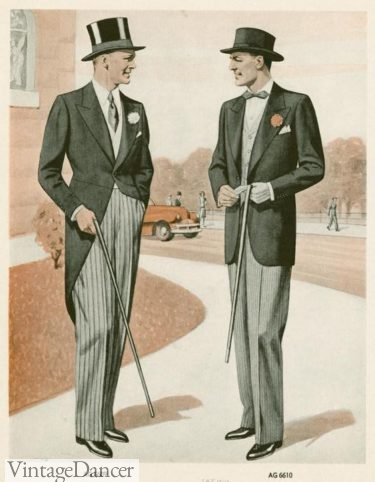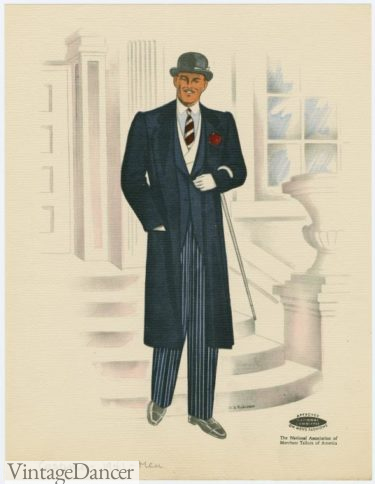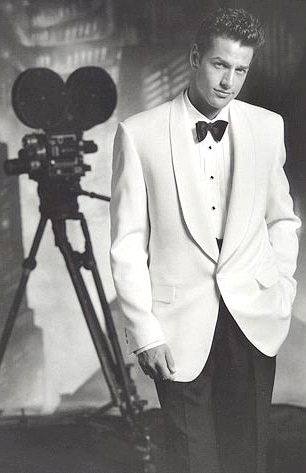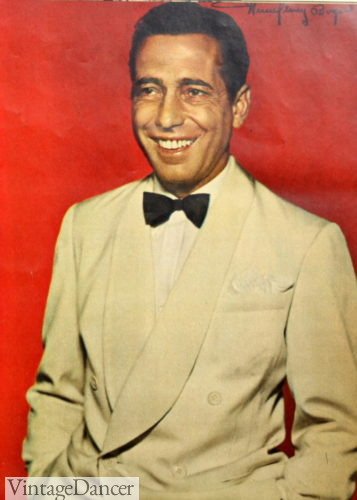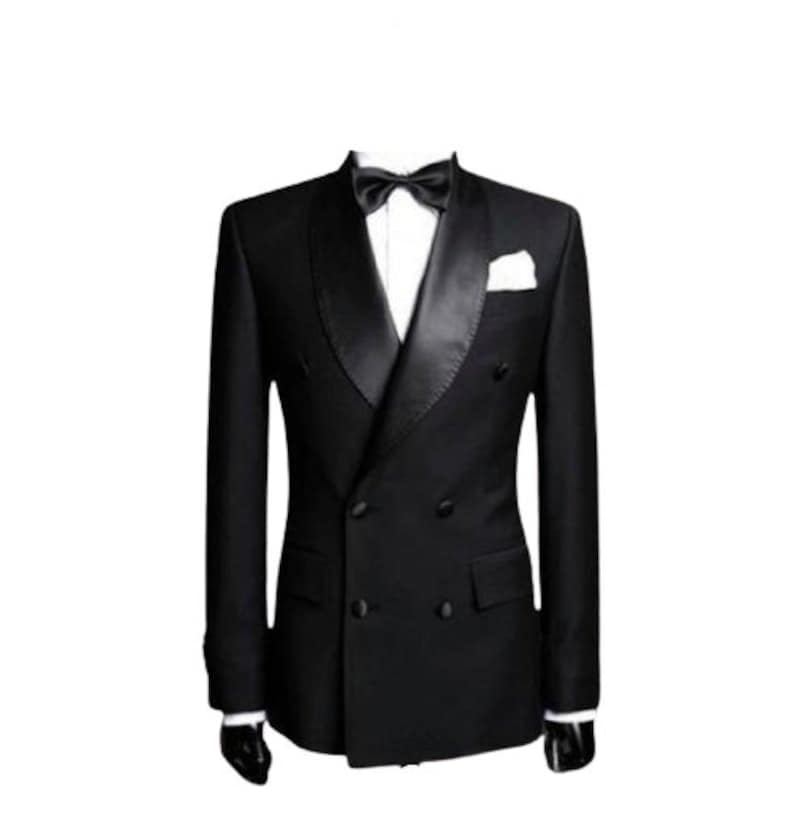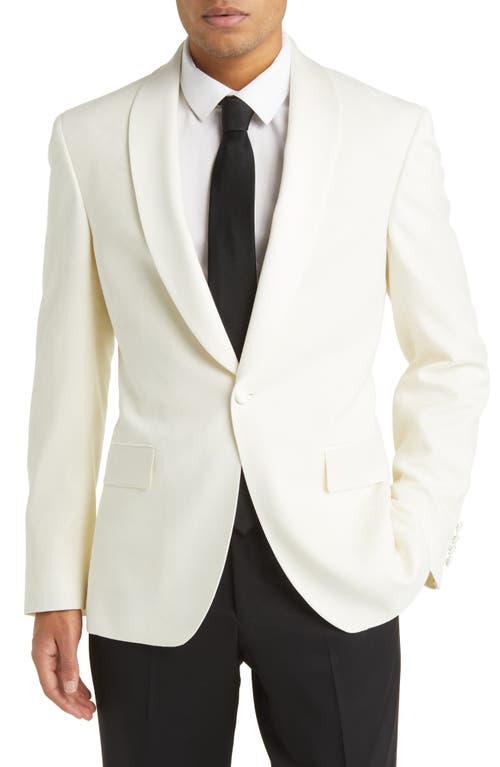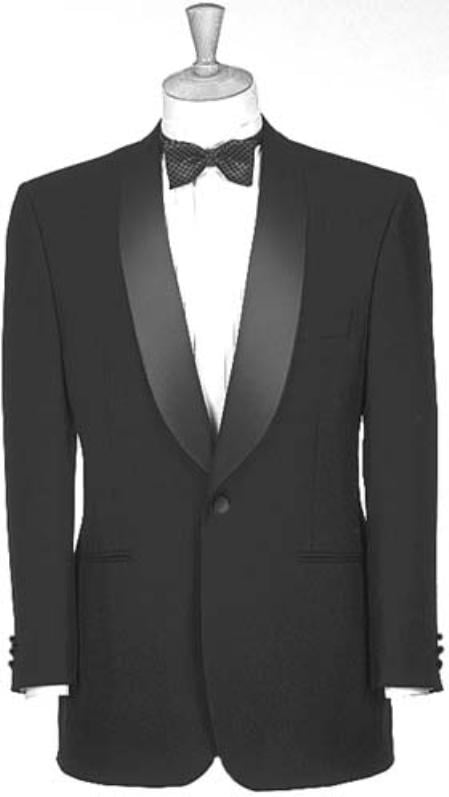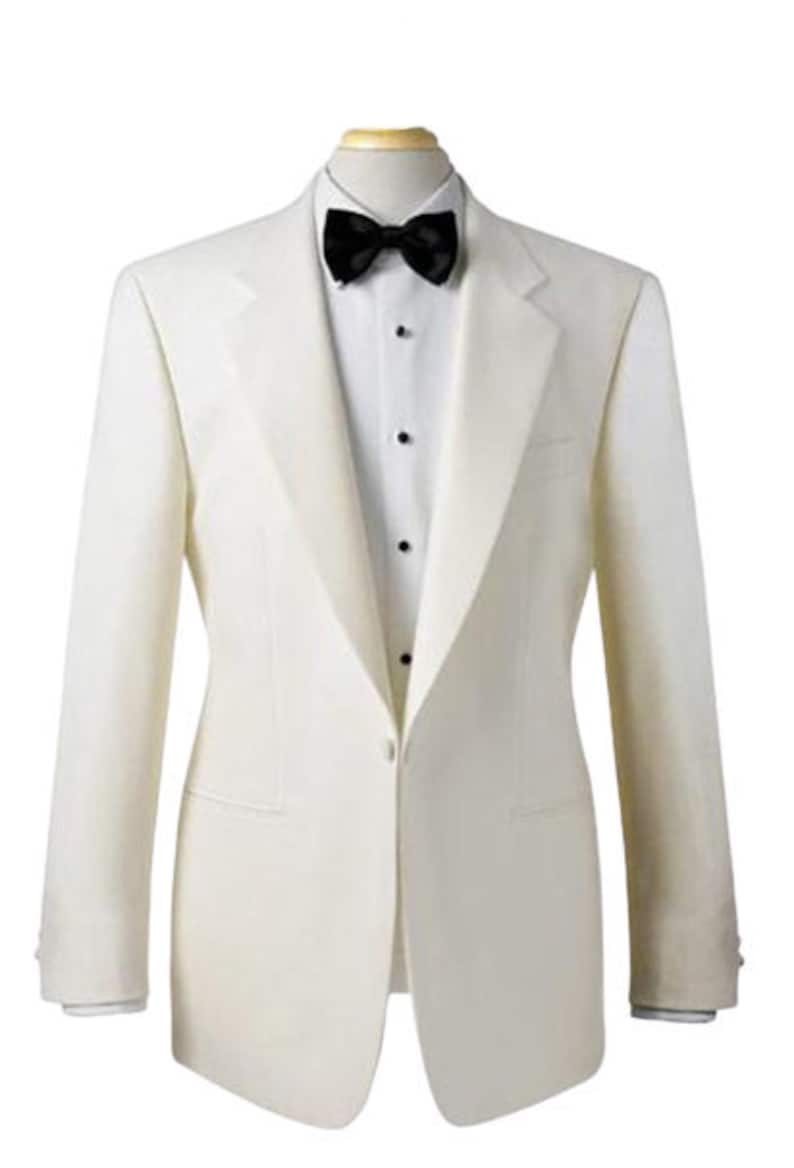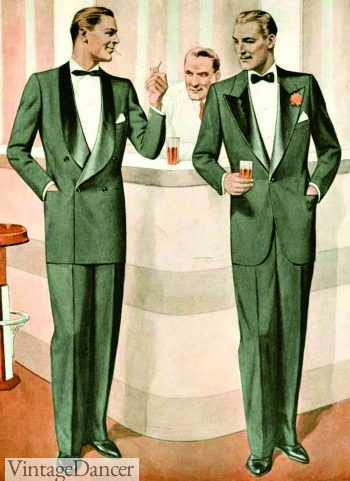
1940s formal men’s attire
Dressing up in black tuxedos, tails, or dinner jackets was a regular affair even in the depression of the 1930s. For city folks and those wealthy enough to afford a night out for dinner and dancing, gentlemen always wore formalwear, as did the wait staff and musicians. During wartime, men’s 1940s formalwear was put aside as many nightclubs were shut down, and instead the focus was on practical day wear. Those who did venture out for a night on the town pieced together older dinner suits or wore their nicest business suits or military uniforms instead. Often times, the staff was better dressed than the customer.
After the war, there was a return to formal attire, but now with a more relaxed look and less rigid rules governing what to wear to a black or white tie event.
To rent a tuxedo visit The Men’s Warehouse online.
Wartime Restrictions
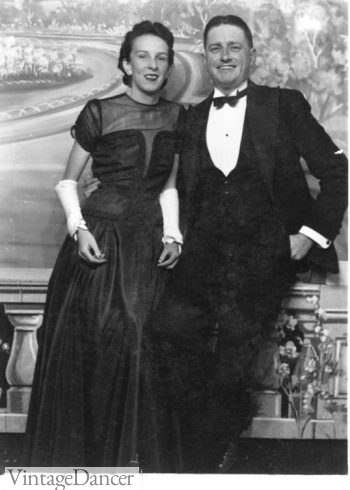
Black Tie Dinner Suit
The few men who did continue to wear formalwear in the 1940s were usually of an older class. Manufacturers who made formal suits were limited by the War Production Board regulations. Double breasted jackets were not allowed and stiff front dress shirts were banned. These restrictions were lifted after the war, but the desire for a simple look remained. The only time men wore tails was for the most formal occasions, such as a charity ball, fancy dinner, evening weddings, and opening night at the opera. These “white tie” events no longer prohibited black tie dress that the younger generation preferred. Instead, the events were a mix of formal and semi formal tuxedos, tails, and business suits.
Men’s traditional 1940s formalwear choices were: white tie (formal), black tie (semi formal), and summer formals (semi formal)
1940s White Tie Formalwear
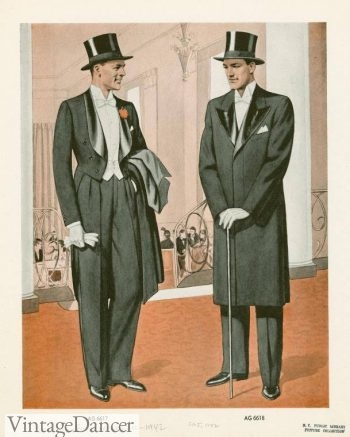
1942 Men’s White Tie Formalwear
White tie formalwear is mostly the same today as it was in the 1940s. It included the following:
- Black tailcoat with satin lapels in a rounded shawl collar shape or with wide pointed peak lapels (see above).
- White button down or stiff front (or pleated) wingtip dress shirt.
- Suspenders, typically white.
- White silk bow tie.
- White single-breasted dress vest with long square lapels.
- High waist, pleated tuxedo pants with a satin stripe down the outer leg.
- Patent leather tuxedo shoes or plain polished leather Oxfords.
- Black socks in silk or wool.
- White gloves.
- White pocket square.
- Colorful silk flower boutineer.
- Black silk top hat.
- (Optional) Dark blue or grey overcoat with satin lapels and dress cane.
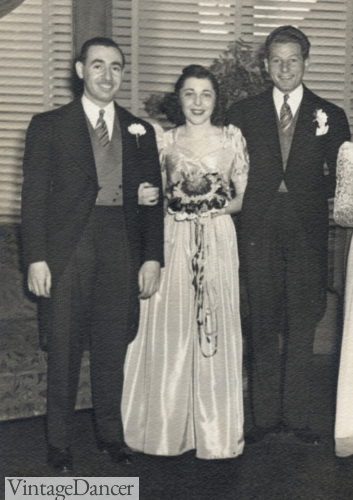
1949 morning suits for the groom and groomsmen
A morning suit was formalwear worn by upper class men during the daytime. It was mostly out of style by 1940 with a few traditional events and weddings still calling for them. They are popular wedding suits today.
- 1942 Morning suit and tuxedo
- 1941 Morning Suit
1940s Black Tie
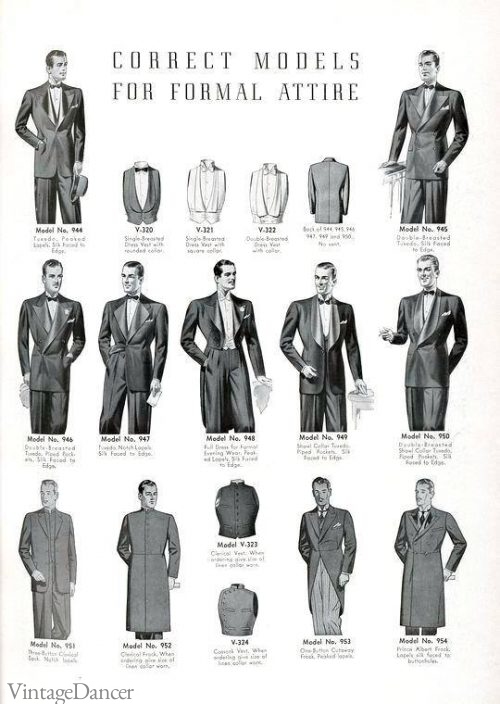
1942 Men’s Formalwear Options
Black tie formalwear was increasingly popular from the 1920s onward. It could be worn wherever formalwear was requested, with a few different looks to choose from:
- Dinner jacket with wide silk (or satin) peak lapels and a nipped in waist. The drape was long, to mid thigh. Single or double breasted jackets were worn as well as the shawl collar jacket. It could be black or midnight blue with black satin lapels.
- White stiff front starched shirt with an extra large wingtip collar.
- Black shawl collar dress vest (backless is OK).
- Black pleated pants with stain stripe or braid on outer legs, very high waist.
- Black or dark blue “club” bow tie (not a fat butterfly shape or skinny ribbon).
- White pocket square (the twin peaks was the best fold).
- (Optional) Black shirt studs and cuff links.
- (Optional) White woven knit or silk shawl (muffler) with monogram initials.
- (Optional) Black homburg hat.
1948 and the Bold Look
The bold look of the late 1940s that would later dominate the early 1950s reintroduced men to exaggerated formality (thanks to movie stars who demonstrated the new fad on the silver screen). In formalwear, this meant a return of the wide and boxy double breasted jacket with extra wide peak lapels that were last seen in the 1930s.
Dress shirts went the opposite direction of the formal jacket with new soft silk or cotton broadcloth dress shirts and semi soft pleated tuxedo shirts with fold down collars (AKA normal dress shirt collars). These new shirts were a welcome change from stiff shirts and collars of yesteryear.
Summer Whites Semi-Formal
- Mr. Bogart looking sharp in a white dinner jacket
- 1942 Bogart wears a cream dinner jacket
The informal summer suit that exploded in the 1930s was still worn in the 1940s. Thanks to tropical worsted wools, the jackets were now much lighter to wear.
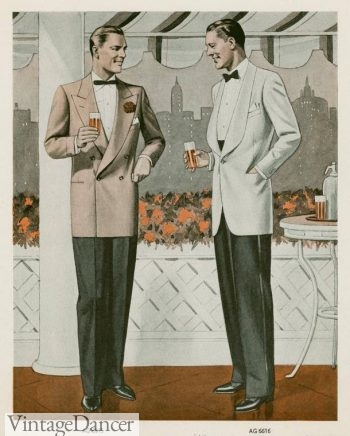
1942 Men’s Summer Semi Formal Attire
The fit was wide and loose and included:
- White, ivory, or tan single or double breasted shawl collar jackets.
- White button down dress shirt or pleated front shirt (no wingtips).
- White suspenders.
- Black or blue dress trousers or satin stripe or braid tuxedo pants.
- Black or midnight blue cummerbund.
- Black polished leather dress shoes.
- Black bow tie (wide or skinny shapes).
- White silk pocket square (late ’40s could be colored).
- Black, dark blue, maroon silk flower boutineer.
- (Optional) Straw hat with white linen band.
Men’s 1940s Formalwear for You
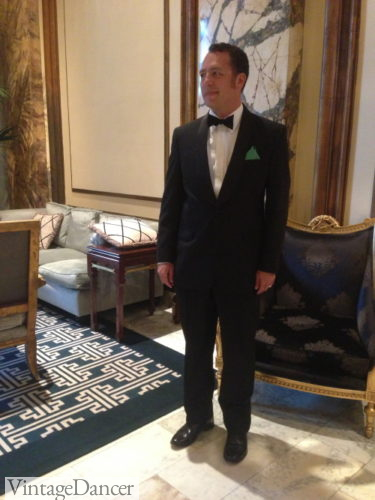
Shawl collar tuxedo for a late 40s formal evening
A few years ago, my husband and I had to dress up for a formal ’30s-’40s dinner and dance. I did the research and wanted to get him a peak lapel dinner jacket. I had a hard time finding one, so instead I bought a shawl collar jacket and pants from Jos. A. Bank. We paired it with a formal smooth front dress shirt, black bow tie and a green pocket square to match my dress, which was not period correct.
Men’s formalwear today is limited. Most shops don’t even sell them, only rent. Jos A. Bank is one exception. While the cut isn’t exactly ’40s, you can get satin stripe pants (flat front, unfortunately) that fit rather high on the waist, black or white dinner jacket with shawl lapels, plain or pleated dress shirts, bow ties, cuff links… pretty much everything you will need for a *mostly* 1940s inspired formal look.
The hardest items to find are white or black formal vests with a deep cut and wide lapels.
To rent a tuxedo visit The Men’s Warehouse online.
Do avoid these items:
- Colorful cummerbunds (yuck, ugly!).
- 6 button vests. These are too modern. If you can’t find the elusive white formal vest don’t wear one.
- Skinny fit tuxedos – just say no.
- Ruffled tuxedo shirt (those are ’70s).
- Pattern tuxedo coats with black lapels. Again too modern.
Here are some 1940s style formal clothes to buy online
Debbie Sessions has been teaching fashion history and helping people dress for vintage themed events since 2009. She has turned a hobby into VintageDancer.com with hundreds of well researched articles and hand picked links to vintage inspired clothing online. She aims to make dressing accurately (or not) an affordable option for all. Oh, and she dances too.
